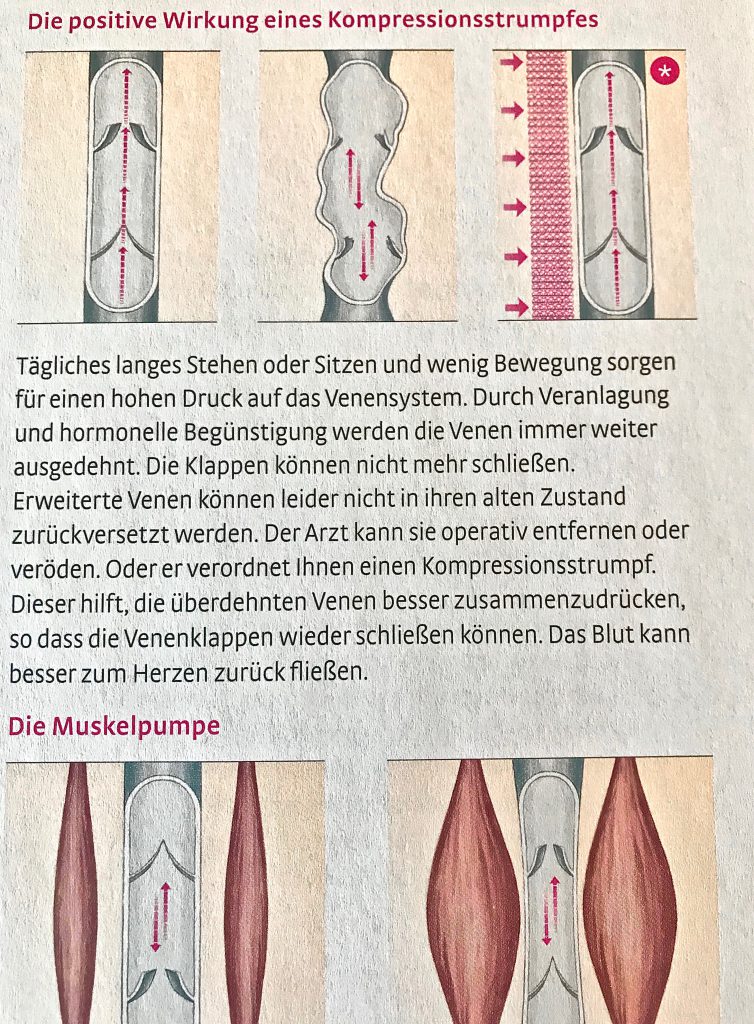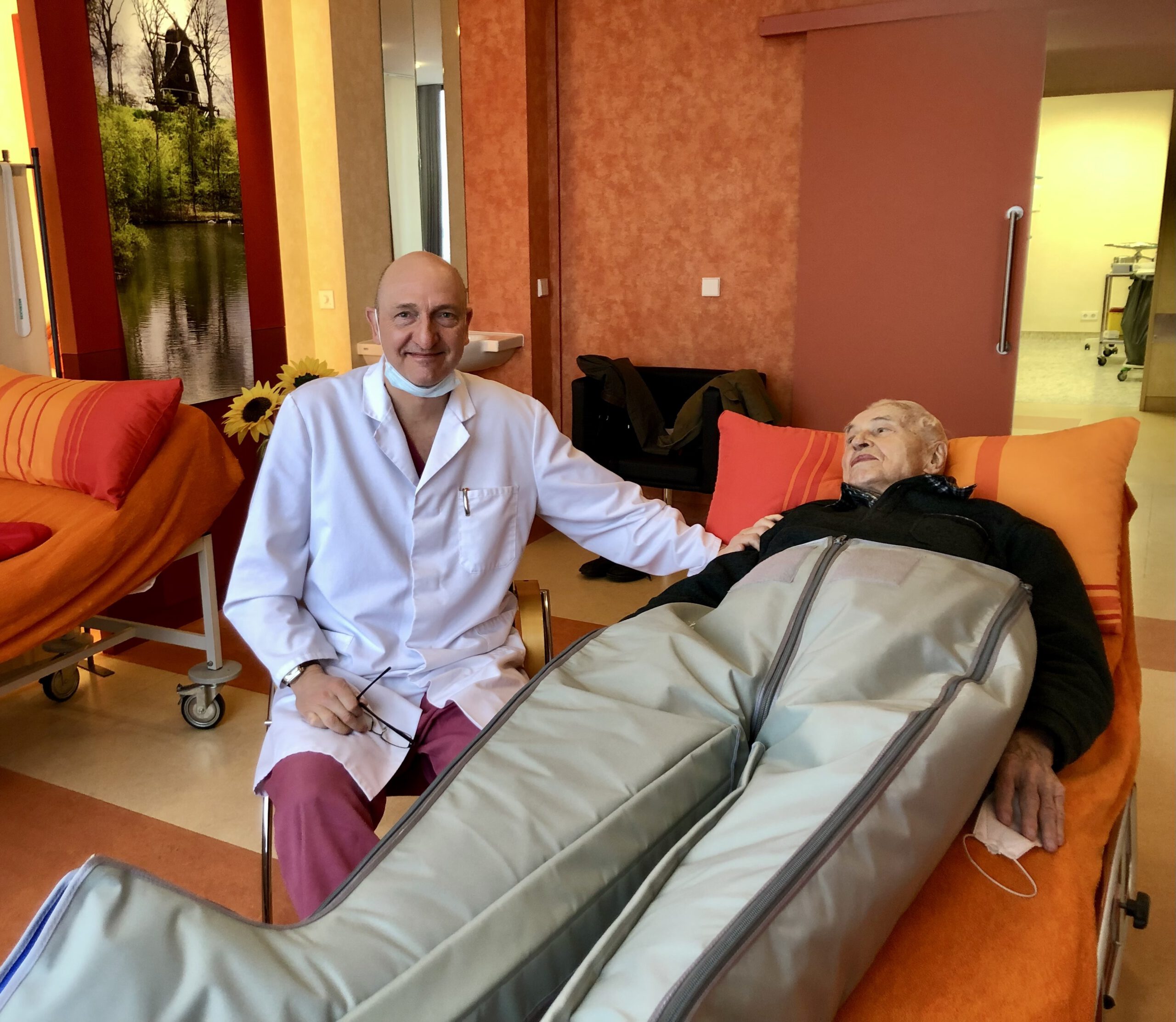Saphenion®: compression in varicose veins
Saphenion®: compression in varicose veins – focuses primarily on subjective leg discomfort. Stasis and heaviness, swelling, and pressure on the ankle are unmistakable signs of a possible chronic venous disease. This is commonly referred to or described as chronic venous insufficiency. The term „chronic venous insufficiency“ thus summarizes disorders of the venous – and also functionally coupled – of the lymphatic return current.
Saphenion®: compression in varicose veins – Pathological factors of chronic venous insufficiency (CVI)
1. Mechanical obstruction of venous return flow (venous occlusion, condition after thrombosis).
2. Defective venous valves of the deep venous system (conduction insufficiency)
3. Defective venous valves of connecting veins (perforator veins) between the skin and deep venous system.
4. Defective venous valves of the skin vein system (subfascial/epifascial).
There is a close relation between venous and lymphatic outflow from the legs, so that the venous system, lymphatic system, and the extracellular space in the overall picture of the so-called low-pressure system form a functional unit. About one-third of the total filtration volume is regulated by the lymphatic vessels. If there is a disruption of the connection veins acting as safety valves (in the context of varicose veins formation), initially venous edema develops followed by lymphedema.

Saphenion®: compression in varicose veins – External factors influence veno-lymphatic reflux
Orthopedic diseases (spreading/lowering foot, ankle arthrodesis, etc.) can also be a cause of the disturbance of the reflux, as well as inborn venous wall weaknesses. The resulting varicose veins lead via the same mechanisms to irreversible damage to the entire peripheral low-pressure system. It develops a venous backflow with permanently increased capillary pressure of approx. 100 – 110 mmHg. This permanently increased capillary pressure thus disturbs the entire local microcirculation. This results in venous edema, followed by lymphedema with disturbances in the transport capacity of both systems. Primarily chronic venous stasis develops into chronic venous insufficiency and later lympho-venous insufficiency. The consequences are severe damage to the skin, slowing of the blood flow, injury to the inner walls of the veins, and increased coagulability of the blood with the risk of thrombosis of the deep veins. In addition, the Symptoms of Heavy feeling, tendency to swell, restlessness in the legs, and rest cramps are extremely stressful for the working person. Thus, there is a need for symptomatic and prophylactic therapy.
Saphenion®: compression in varicose veins – is high compression pressure getting better?
In recent years, a noticeable change in the indication for compression therapy has occurred in professional circles. Still, 5 years ago, the principle to prescribe compression stockings of class 2 and lymphoedema class 3 for each varicose vein, today is rather the opposite. We move away from the inconvenient, heavy-wearing, restrictive, ill-fitting, and tight compression stockings to lighter forms of compression. This applies both to compression alone and to compression after therapeutic procedures on the venous system.
Saphenion®: Compression in varicose veins – Compression class 1-2 in mild CVI, after microfoam and catheter therapy varicose veins.
We began 3 years ago to change our prescription regime to treat patients with mild CVI and after endovenous procedures using microfoam or vein glue with the class 1 compression stocking, which is more comfortable and subjectively much more comfortable. Of course, this „downgrading“ always depends on the individual clinical findings of CVI and varicosis, but we have received positive feedback. In equally good postoperative courses, the patients report much more positively, no longer complain of pressure pain and problems when wearing the tighter stockings, Also, the difficulties of the elderly patients when putting on the stockings are no longer evident. For lymphatic and lipoedema, we now prefer compression class 2 and additionally prescribe regular lymphatic massages or perform them ourselves.
Saphenion®: compression in varicose veins – Compression as prophylaxis for sitting/standing occupations
The Saphenion Protocol: Compression primarily sees a prophylactic effect of compression therapy. All patients with sitting or standing professions or also with pronounced travel activity via airplane receive compression stockings between 17-20 mm Hg. These are offered by different manufacturers as so-called travel stockings also already.
For two years now, we have noticed a significant increase in interest in our two venous centers. The patients are extremely satisfied with this new type of compression stocking therapy and describe the positive effects impressively.
But in sports, these lighter compression stockings play a major role now. In all running sports and team sports (football, handball, American football, etc.), many athletes now wear so-called sports compression stockings during their arrival and during the games.
We have had excellent experiences with the football team of the Rostock Griffins. Both the willingness to perform and the training intensity could be increased. In addition, there were significantly fewer injuries to the muscle/ligaments of the legs in the period of our studies!

Photos: Utzius
Links/papers:
Back TL, Padberg FT Jr, Araki CT, Thompson PN, Hobson RW 2nd. Limited range of motion is a significant factor in venous ulceration. J Vasc Surg. 1995 Nov;22(5):519-23. doi: 10.1016/s0741-5214(95)70030-7. PMID: 7494349.
Youn YJ, Lee J. Chronic venous insufficiency and varicose veins of the lower extremities. Korean J Intern Med. 2019 Mar;34(2):269-283. doi: 10.3904/Jim.2018.230. Epub 2018 Oct 26. PMID: 30360023; PMCID: PMC6406103.
Netzer, CO und G.Rudowski: Praktische Ambulante Phlebologie; Medical Concept GmbH, München; 1991
Orr L, Klement KA, McCrossin L, O’Sullivan Drombolis D, Houghton PE, Spaulding S, Burke S. A Systematic Review and Meta-analysis of Exercise Intervention for the Treatment of Calf Muscle Pump Impairment in Individuals with Chronic Venous Insufficiency. Ostomy Wound Manage. 2017 Aug;63(8):30-43. doi: 10.25270/owm.2017.08.3043. PMID: 28873064.
Santler B, Goerge T. Chronic venous insufficiency – a review of pathophysiology, diagnosis, and treatment. J Dtsch Dermatol Ges. 2017 May;15(5):538-556. doi: 10.1111/ddg.13242. PMID: 28485865.
Siegenthaler W.: Klinische Pathophysiologie; Georg Thieme Verlag Stuttgart, New York; 1987
Weber, J und May,R.: Funktionelle Phlebologie; Georg Thieme Verlag Stuttgart, New York; 1990
https://www.der-niedergelassene-arzt.de/publikationen/zeitschriften/vasomed/aktuelle-ausgabe
https://www.leading-medicine-guide.de/erkrankungen/kreislauf/chronisch-venoese-insuffizienz
https://aok-pfiff.de/haeufige-krankheitsbilder/chronisch-venoese-insuffizienz-cvi
https://www.lymphnetzwerk.de/venen/erkrankung/cvi.html
